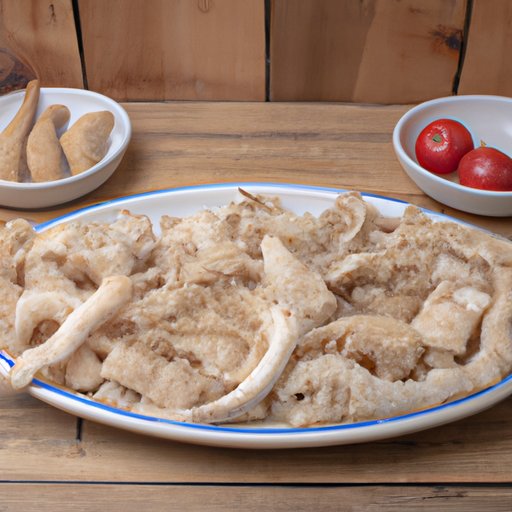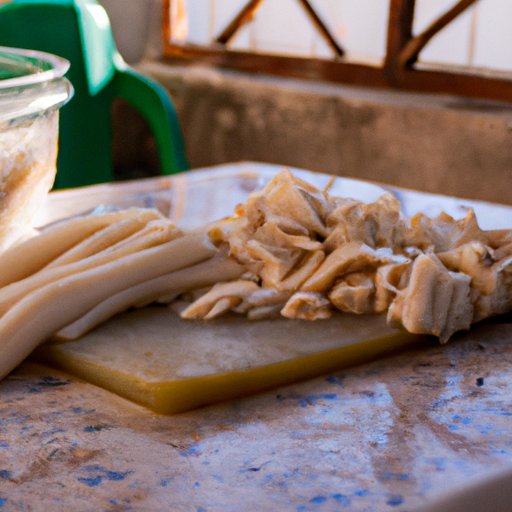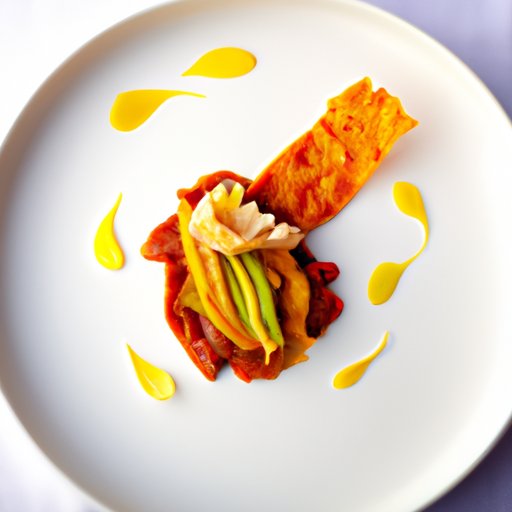Introduction
Tripe is a type of edible offal made from the stomach lining of various animals. It is a popular dish in many cultures around the world and is known for its versatility and rich flavor. In this article, we will explore the history and origin of tripe, the many health benefits associated with eating it, tips for preparing and cooking it, and some delicious recipes to try.
Exploring the History and Origin of Tripe
Tripe has been eaten since ancient times and is believed to have originated in the Middle East. It was mentioned in the Bible as being an integral part of the Israelites’ diet. Tripe was also popular in Ancient Greece and Rome, where it was served as a delicacy to the wealthy. In Europe, tripe was often eaten by the lower classes as a cheap source of protein.
Today, tripe is still popular in many parts of the world. It is a staple in French cuisine and can be found in dishes like the classic French stew, tripes à la mode de Caen. In Mexico, tripe is used in a variety of dishes such as menudo and pozole. In China, it is commonly served stir-fried or in soups. Tripe is also popular in Africa, particularly in Ethiopia, where it is served with injera bread.

The Many Health Benefits of Eating Tripe
Tripe is a highly nutritious food that provides a range of health benefits. It is a good source of vitamins and minerals, including iron, zinc, phosphorus, and B vitamins. It is also a good source of protein, with one serving providing up to 15 grams of complete protein.
In addition to its nutritional value, tripe is thought to have potential health benefits. Some studies suggest that eating tripe may help reduce cholesterol levels, lower blood pressure, and reduce inflammation. It is also believed to aid digestion and boost the immune system. However, more research is needed to confirm these potential benefits.

Tips for Preparing and Cooking Tripe
When preparing tripe, it is important to choose the right cut. Beef tripe is the most common type, and it comes in several different cuts: honeycomb, book, blanket, and reed. Each cut has a distinct texture and flavor, so it is important to choose the right one for the dish you are making.
Tripe should be thoroughly washed before cooking. It is also important to cook it slowly over low heat to ensure that it is tender and flavorful. Common ways to cook tripe include boiling, stewing, frying, and baking. When cooked correctly, tripe should be juicy and tender with a slightly chewy texture.
Recipes for Making Delicious Tripe Dishes
Tripe can be used in a variety of dishes, from stews and soups to salads and sandwiches. Here are three delicious recipes to try:
Classic Stewed Tripe
This classic French dish is easy to make and full of flavor. It can be served on its own or over rice or mashed potatoes. To prepare, season diced beef tripe with salt and pepper, then brown in a skillet with olive oil. Add chopped onions, garlic, and carrots and sauté until soft. Pour in a cup of red wine and simmer for 30 minutes. Add diced tomatoes, bay leaves, thyme, and parsley, then cook for another 30 minutes until the tripe is tender. Serve hot.
Fried Tripe with Onions
This simple dish is great for a quick lunch or dinner. Start by washing and patting dry diced beef tripe. Heat a skillet with vegetable oil and add the tripe. Cook until lightly browned, then add sliced onions and garlic and cook until the onions are softened. Season with salt and pepper to taste and serve hot.
Tripe Soup
This comforting soup is perfect for a cold winter day. Begin by soaking diced beef tripe overnight in cold water. Drain and rinse, then add to a pot with chicken broth, diced potatoes, carrots, celery, and onion. Simmer until the vegetables are tender, then season with salt and pepper to taste. Serve hot with a sprinkle of fresh herbs.
Different Varieties of Tripe and How to Identify Them
Tripe comes from several different animals, including cows, sheep, and pigs. Each type of tripe has its own distinct flavor and texture, so it is important to know which one to use for each dish.
Beef Tripe
Beef tripe is the most common type and can be found in most supermarkets. It has a mild flavor and a slightly chewy texture. It is usually sold in cubes or strips and is ideal for stews, soups, and casseroles.
Lamb Tripe
Lamb tripe has a strong flavor and a very tender texture. It is usually sold in thin sheets and is best suited for dishes like stir-fries and soups. Lamb tripe can be harder to find than beef tripe, but it is worth seeking out for its unique flavor.
Pig Tripe
Pig tripe has a mild flavor and a slightly chewy texture. It is usually sold in cubes or strips and is ideal for stews, soups, and casseroles. Pig tripe can be harder to find than beef or lamb tripe, but it is worth seeking out for its unique flavor.

Ideas for Serving Tripe in Creative Ways
Tripe can be served in a variety of creative ways. One idea is to stuff it with herbs and spices and wrap it in foil before baking. Another is to add it to salads for a protein-packed meal. You can also marinate it in a mixture of oil, vinegar, and spices before grilling or frying it.
Conclusion
Tripe is a versatile and nutritious food that has been enjoyed for centuries. It is a good source of protein, vitamins, and minerals and is thought to have potential health benefits. When preparing and cooking tripe, it is important to choose the right cut and cook it slowly over low heat. There are many delicious recipes for making tripe dishes, from stews and soups to salads and sandwiches. With a little creativity, tripe can be a tasty and healthy addition to any meal.
(Note: Is this article not meeting your expectations? Do you have knowledge or insights to share? Unlock new opportunities and expand your reach by joining our authors team. Click Registration to join us and share your expertise with our readers.)
